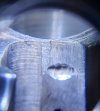Ian
Notorious member
So I have this basket case silhouette revolver made out of a rusted-out Brazilian contract 1917. At some point in its life after the rebarreling it either had a stuck bullet or, more likely, a lot of very spicy handloads put through it, spicy enough to bulge the bull barrel in front of the frame and bulge the frame enough to taper the barrel threads. The barrel threads start very loose and end up very snug with no wiggle the last turn or so before its shoulder contacts the face of the frame. The flare of the frame opening toward the muzzle end is visible in the light reflecting off of the finish.
Since Glen posted about his snub-nosed, full shroud, custom model 25 I have been thinking of doing similar with this revolver because otherwise it is doomed to remain a bag of parts taking up space here. The question I have is how to deal with the tapered threads in the frame when I re-barrel it? I suppose I could turn and blue a mandrel to identify the exact taper of the threads, offset my tailstock to match, and cut tapered barrel threads to match the frame. The other option would be to chase out the frame threads at the same pitch but slightly larger diameter to clean them up to parallel....though that would be more tricky as far as setup to single-point them in a lathe or make a custom tap. There isn't enough meat to bore the frame to a larger, standard thread size for which I might be able to find a commercial tap. Being a .45 ACP, I don't think that resurrecting this rather than scrapping it would be dangerous with standard loads, but from a machining point of view I don't know what would be the best approach to fixing the tapered frame so the new barrel has full support where it passes through the frame.
Third option might be cut standard threads on the barrel tenon and install it with a liberal dose of epoxy. Anyone know of an epoxy or glue that has 25-30,000 PSI of compressive strength?
Since Glen posted about his snub-nosed, full shroud, custom model 25 I have been thinking of doing similar with this revolver because otherwise it is doomed to remain a bag of parts taking up space here. The question I have is how to deal with the tapered threads in the frame when I re-barrel it? I suppose I could turn and blue a mandrel to identify the exact taper of the threads, offset my tailstock to match, and cut tapered barrel threads to match the frame. The other option would be to chase out the frame threads at the same pitch but slightly larger diameter to clean them up to parallel....though that would be more tricky as far as setup to single-point them in a lathe or make a custom tap. There isn't enough meat to bore the frame to a larger, standard thread size for which I might be able to find a commercial tap. Being a .45 ACP, I don't think that resurrecting this rather than scrapping it would be dangerous with standard loads, but from a machining point of view I don't know what would be the best approach to fixing the tapered frame so the new barrel has full support where it passes through the frame.
Third option might be cut standard threads on the barrel tenon and install it with a liberal dose of epoxy. Anyone know of an epoxy or glue that has 25-30,000 PSI of compressive strength?

